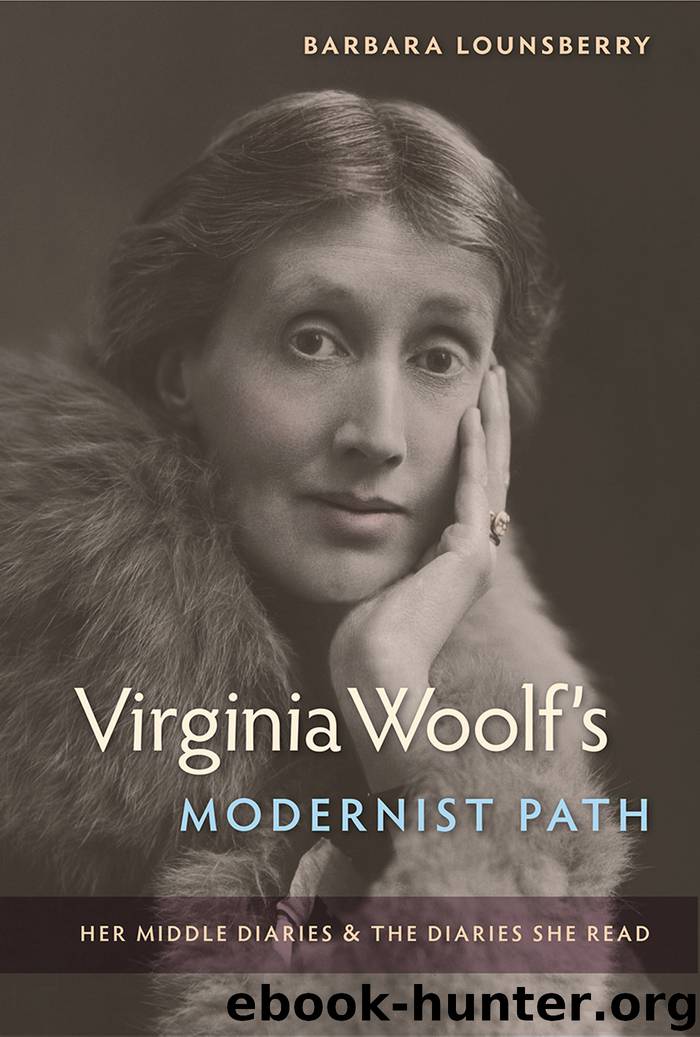Virginia Woolf's Modernist Path by Lounsberry Barbara;

Author:Lounsberry, Barbara;
Language: eng
Format: epub
Publisher: University Press of Florida
Published: 2019-03-18T16:00:00+00:00
7
Renewed Diary Experiment
The Reach for Literature and Beyond
Virginia Woolf expands her diary in 1926. She extends her diary further toward literature—and beyond. In February she begins “a new convention” for her diary. She will start each entry on a new page, her “habit in writing serious literature” (D 3: 62). Can there be clearer sign of her recommitment to her diary as art? In May and June, she expands outward toward public history with a diary of the General Strike. She then turns inward in the country for eleven titled “State of Mind” entries—probes of the boundaries between sense, thought, and art.
Her mind thus stretches this year toward worlds that “exist” beyond herself and her art. At the end of October, she imagines “an endeavour at something mystic, spiritual; the thing that exists when we aren’t there” (D 3: 114). The diaries she reads propel her toward this place. Across the year Woolf returns again and again to Beatrice Webb’s memoir My Apprenticeship, which is woven around diary extracts. This is unusual behavior for Woolf. Of all the diaries Woolf reads across her second, modernist stage, the diary excerpts in My Apprenticeship most shape her thought. They supply notions for To the Lighthouse, The Waves, Flush: A Biography, and Three Guineas—and especially for A Room of One’s Own and “Professions for Women.”
In September, Woolf reviews a handsome two-volume edition of the Journals of Thomas Cobden-Sanderson, the artist of The Book Beautiful. They offer a male complement to the potent diary extracts in My Apprenticeship. Like Webb and Woolf, Cobden-Sanderson faced bouts of depression throughout his life that led to thoughts of suicide. Like them, he sought relief in his diary and through his own form of mystical belief. Cobden-Sanderson’s questing Journals likely encouraged Woolf’s search in September 1926 (and after) for “the mystical side of this solitude,” she writes (D 3: 113)—or what Webb calls the great Unknown.
Soon after, Woolf reviews a new reprint of the Life of Benjamin Robert Haydon, Historical Painter, from his Autobiography and Journals. Haydon and Woolf share the same January 25 birthday. She finds in his Journals her diary father (Sir Walter Scott), her diary mother (Fanny Burney), and many old diary friends. More than this, Haydon’s Journals offer her a memorable moment for To the Lighthouse, matter for A Room of One’s Own, and figures for Flush.
Download
This site does not store any files on its server. We only index and link to content provided by other sites. Please contact the content providers to delete copyright contents if any and email us, we'll remove relevant links or contents immediately.
| Ancient & Classical | Arthurian Romance |
| Beat Generation | Feminist |
| Gothic & Romantic | LGBT |
| Medieval | Modern |
| Modernism | Postmodernism |
| Renaissance | Shakespeare |
| Surrealism | Victorian |
4 3 2 1: A Novel by Paul Auster(12281)
The handmaid's tale by Margaret Atwood(7678)
Giovanni's Room by James Baldwin(7188)
Asking the Right Questions: A Guide to Critical Thinking by M. Neil Browne & Stuart M. Keeley(5631)
Big Magic: Creative Living Beyond Fear by Elizabeth Gilbert(5610)
Ego Is the Enemy by Ryan Holiday(5292)
The Body: A Guide for Occupants by Bill Bryson(4974)
On Writing A Memoir of the Craft by Stephen King(4863)
Ken Follett - World without end by Ken Follett(4643)
Adulting by Kelly Williams Brown(4486)
Bluets by Maggie Nelson(4472)
Eat That Frog! by Brian Tracy(4432)
Guilty Pleasures by Laurell K Hamilton(4358)
The Poetry of Pablo Neruda by Pablo Neruda(4038)
Alive: The Story of the Andes Survivors by Piers Paul Read(3967)
White Noise - A Novel by Don DeLillo(3953)
Fingerprints of the Gods by Graham Hancock(3940)
The Book of Joy by Dalai Lama(3898)
The Bookshop by Penelope Fitzgerald(3775)
